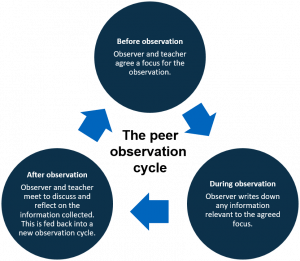Richards & Farrell (2005) describe peer observation as ‘a teacher or other observer closely watching and monitoring a language lesson or part of a lesson in order to gain an understanding of some aspect of teaching, learning, or classroom interaction.’
This idea of observations being a positive experience which can benefit both the observer and the teacher being observed is something that I have embraced during my teaching career and has been an essential part of my development as a teacher.
In contrast, I have a problem with assessed observations. I have always fundamentally believed that observations should be about teacher development rather than judgement. Cosh (1999) argues that teaching styles and methods are very subjective, and therefore, not only that we are unqualified to judge our peers, but also that our judgements are subjective, and therefore of limited and questionable value to anyone other than ourselves.
Richards & Farrell (2005) discuss the limitations of observations and how these should be taken into account. Firstly, describing what is visible to the observer:
- Timing
- Activities
- Questioning techniques
- Participation
- Classroom language
They then discuss what is not so visible:
- Decision making
- Engagement
- Problems
- Teaching principles
I think the limitation that Richards & Farrell discuss are why I have historically gained far more from teacher development observations than assessed observations. In line with this I agree with Cosh (1999) who argues that ‘in a reflective context, peer observation is not carried out in order to judge the teaching of others, but to encourage self-reflection and self- awareness about our own teaching’.
With regards to peer observations, I am looking forward to observing and being observed by my peers and the benefits it can have on my teaching. In the course of my reading for this module, I stumbled upon the following quote, which in my mind encapsulates what being observed is all about:
‘Observation can also help narrow the gap between one’s imagined view of teaching and what actually occurs in the classroom.’ – Richards & Farrell (2005)
With regards to the peer observation process, I will aim to use O’Leary’s peer observation cycle.
References
- Cosh, J. 1999, “Peer observation: a reflective model”,ELT journal, 53, no. 1, pp. 22-27.
- O’Leary, M. 2014, Classroom observation: a guide to the effective observation of teaching and learning, Routledge, London.
- Richards, J.C. & Farrell, T.S.C. 2005,Professional development for language teachers: strategies for teacher learning, Cambridge University Press, Cambridge.

